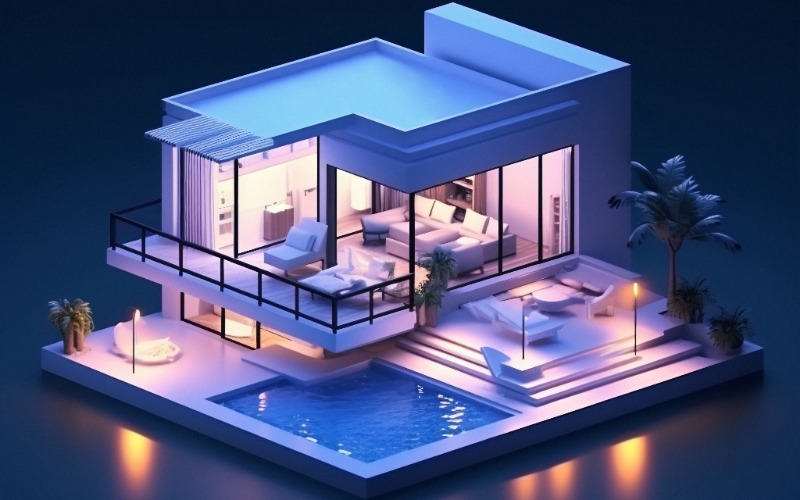In the domain of luxury living, technology has transitioned from a convenience to a necessity. The pivotal role of technology in our homes is increasingly recognized by architects, interior designers, and builders. Clients’ needs for sophisticated home tech are causing industry professionals to seek guidance from home technology integrators in the early stages of design. Despite this slowly growing trend, there is a pressing need to promote the need for early design of home technology systems, even before the involvement of framing contractors or electricians. This is a trend I hope that kicks into high gear in 2024 and beyond.
Networks and Prewire: Building the Digital Backbone
With the increasing complexity of luxury home technology, a robust and high-speed network infrastructure is vital to ensure seamless operation. High-quality, reliable home networks are no longer a luxury but necessary, accommodating the demands of distance learning, video conferencing, and digital entertainment.
The latest high-speed Wi-Fi standard is capable of very high speeds over a shorter distance. As such, more wireless access points (WAP) are needed to ensure all the key areas of the home are covered by fast Wi-Fi. Integrators can help design the ideal layout as they access software that helps determine how many WAPs are needed and where they should be located. And a growing trend is to extend fast Wi-Fi coverage to the home’s outdoor areas.
Despite almost every product having a Wi-Fi connection, it is more vital than ever that a home be properly prewired. This may include running fiberoptic cabling and running empty conduits to key locations to future-proof the home. No matter how fast a Wi-Fi system is, it will never be as secure as a wired Internet connection, and all high-speed video streaming works better when hardwired and doesn’t strain the Wi-Fi system for other needs.
Design-Centric Technologies: When Form Meets Function
There is a clear movement towards integrating technology that complements the home’s interior design. TVs that double as artwork when not in use and invisible speakers are a testament to this trend. The luxury-focused smart home and lighting brands have lighting keypads and flush-mount touch screens available in several finishes to complement the home’s interior aesthetic. Some brands, such as Trufig, have created products to flush mount keypads, lighting dimmers, thermostats, and even electrical outlets. Such seamless integration of technology and design highlights why a home tech integrator should be consulted early.
Lighting and Motorized Shading: Crafting Ambiance
Lighting has surpassed its functional role to become a key element in creating ambiance. The latest trend is human-centric lighting that mimics the sun’s natural cycle, promoting well-being through the support of our circadian rhythms. Such innovative lighting solutions are not just aesthetically pleasing but also offer significant wellness benefits.
Smart Homes: Getting Smarter
The rising popularity of DIY smart home products like Philips Hue lighting, Amazon Alexa, Apple’s HomeKit, and Google Home has provided a glimpse into the potential of integrated smart technology. However, as our reliance on technology has increased, especially evident during the COVID-19 lockdowns, the need for more robust, secure, and high-performance smart home systems has become apparent.
You can expect smart home systems to become ever more accessible, though many clients suffer ‘app fatigue.’ A typical smart home could have a separate app for its alarm system, surveillance cameras, lighting, thermostat, shades, music, TV, pool & spa control, and front door lock. Advanced home control systems from brands such as Crestron, Control4, and Savant can unify all this control into a single app!
Home Entertainment: The Luxury Theater Revival
The pandemic lockdown reignited the love for high-performance home theaters and media rooms. Immersive audio formats have evolved, adding height channel speakers that envelop viewers in cinematic worlds. The CEDIA and CTA’s RP22 document is a new guide helping entertainment system designers tailor immersive audio systems for diverse environments. We have reached the point where a well-designed home entertainment system can exceed the performance of even the best commercial cineplexes.
In many high-end residences, large-format DVLED displays are becoming the centerpiece, replacing front projection screens. Quantum Media Systems and LG are at the forefront, offering vibrant displays that make the home theater experience extraordinary, even in well-lit rooms. These large screens can also be purposed as a ‘digital canvas’, being used to display still or motion artwork. In the past, architects and interior designers frowned on seeing video displays in the common areas of a home due to the visual distraction, but when it’s used as a digital art display, it becomes a focal point and conversation piece.
Home Security: The AI Revolution
Artificial Intelligence (AI) has revolutionized home security systems, offering meaningful notifications and minimizing false alarms. Today’s best camera systems can automatically open gates or locks from being able to read license plates and do facial recognition, further aiding convenience.
EV Charging Stations and Energy Management: The Sustainable Home
The surge in electric vehicle ownership has introduced the need for home-integrated EV charging solutions. Homeowners now desire comprehensive energy management systems that intelligently manage power during outages, leveraging solar power, storage batteries, backup generators, and energy management controllers.
Wellness Technologies: The Health-Conscious Home
A heightened focus on wellness within the luxury home sector has led to the adoption of advanced air purification systems and lighting that support circadian health. These technologies are not just trends but investments in the physical and mental well-being of the occupants. Other home wellness aspects are water purification systems and attention to acoustics. Home tech integrators often work with acoustics experts who can tame the echoey nature of modern interiors full of hard surfaces.
The Rise of the Design-Centric Technology Integrator: The Orchestra Conductor
As the home tech industry has evolved, so have the professionals who design, install, and service these systems. Today’s advanced integrators can be likened to electronic architects, creating design & engineering documentation they use to coordinate the technology systems with the architect and interior designer. The resulting documentation is used to coordinate with electricians, HVAC pros, and any other trade affected by the home’s technologies. When this is done early, there is less wall clutter, change orders, and project delays during new construction and remodel projects.
For a more detailed explanation of the importance and process of creating design and engineering documentation, refer to this informative article.











